 |
| Roy
Langlois in 1947 |
Roy
Brouard
LANGLOIS D.F.C. was prisoner
of war no.653 at Stalagluft Sagan & Belaria. On March 24/25th
1944 he took part in the famous mass escape from Stalg Luft III Sagan
which was the basis for the film "The Great Escape" starring Steve
MacQueen, in which 220 men tried to escape from the camp. In the woods
at the end of the tunnel was Langlois who could see that a patrolling
sentry had deviated from his beat and would tread within a few feet of
the tunnel. He tugged at the signal rope, meaning "stay put." The next
escaper, thinking this was the opposite signal, emerged from the tunnel
right under the feet of the guard, who until then had passed by. For
some seconds he did not see the tracks in the snow and body-heat steam
drifting upwards from the tunnel mouth. Finally noticing the signs, he
raised his rifle, fired a wild shot at Langlois (which missed) and blew
his whistle. Nearly all the men were recaptured and 50 were murdered by
the Gestapo. Langlois ( nicknamed Daddy Long Legs ) was returned to
Sagan. He had already earned the Distinguished Flying Cross before the
war for gallant and distinguished services rendered in connection with
operations in Palestine during the period 1st April 1939 until 30th
July 1939 and was to attain the rank of Wing Commander before retiring
from the RAF in 1962. He was married to Maria Kirby-Green the widow of Squadron-Leader Tom Kirby-Green
one of the RAF officers executed after The Great Escape. He died in 1993 aged 76. See LINKS page to go to
Rob Davis' website on The Great Escape.
The other three G for George airman Sergeant John
McLARNON
POW No139328., Sergeant Harold
Joseph Edwin BURRELL POW
No.139375 and Sergeant R.D.
PORTEOUS POW No.32409. After
splitting off from Langlois, Copley and Newton the three airmen knocked
at the door of a farmhouse at Lierre near Antwerp. The farmers daughter
was probably called Mlle. Justine VAN DEN EYNDE and her and the other
people on the farm hid them for the night and gave them overalls to
wear . The next day they were taken to Antwerp and were hidden in the
house of Mme Beukelaer in Geulincxstraat until the 9th September.
During this time false papers were prepared and arrangements made to
get them to Lisbon by M. and Mme. MEYERBERGER of Brasschaet near
Antwerp. On the 9th September they left Antwerp by train and were met
in Brussels by Mrs Harris who said she originated from Birmingham she
took them to the Rue Washington where they stayed 2 nights with Jean
VANDENHOVE. While staying with Vandenhove they were visited by a silver
haired man called WILLIE (William Reynolds?) who had previously owned a cafe in Ostend. On
the night of the 11th they were taken to the station by Mrs Harris and
left Brussels guided by a Major Du Normand bound for Besancon. On
arrival at Besancon they went by bus to St.Laurent near Lake Geneva
where they stayed the night. The three crossed into Vichy France at 3pm
on the 13th September. They were to rendezvous in a cafe a few
kilometers outside St. Laurent and then were to be taken by taxi to
St.Claude and then by train to Toulouse. But things did not go
according to plan. While they were in the cafe they were spotted by a
Gendarme who questioned them and asked to see their papers. He was not
satisfied with the airmens identity and took them to the local
Gendarmerie where it was established that they were RAF airmen. They
were then interned in St Hippolyte-du-Fort near Nimes, in the South of
France, which contained many British evaders picked up by the Vichy
police.In March 1942 and later taken to Fort de la Revere near Nice
where they remained until August 1942. They were then taken to POW camp
in Germany.
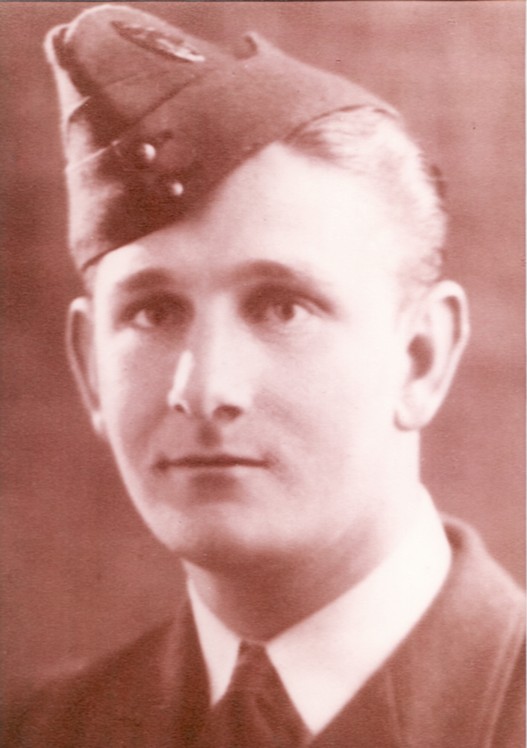
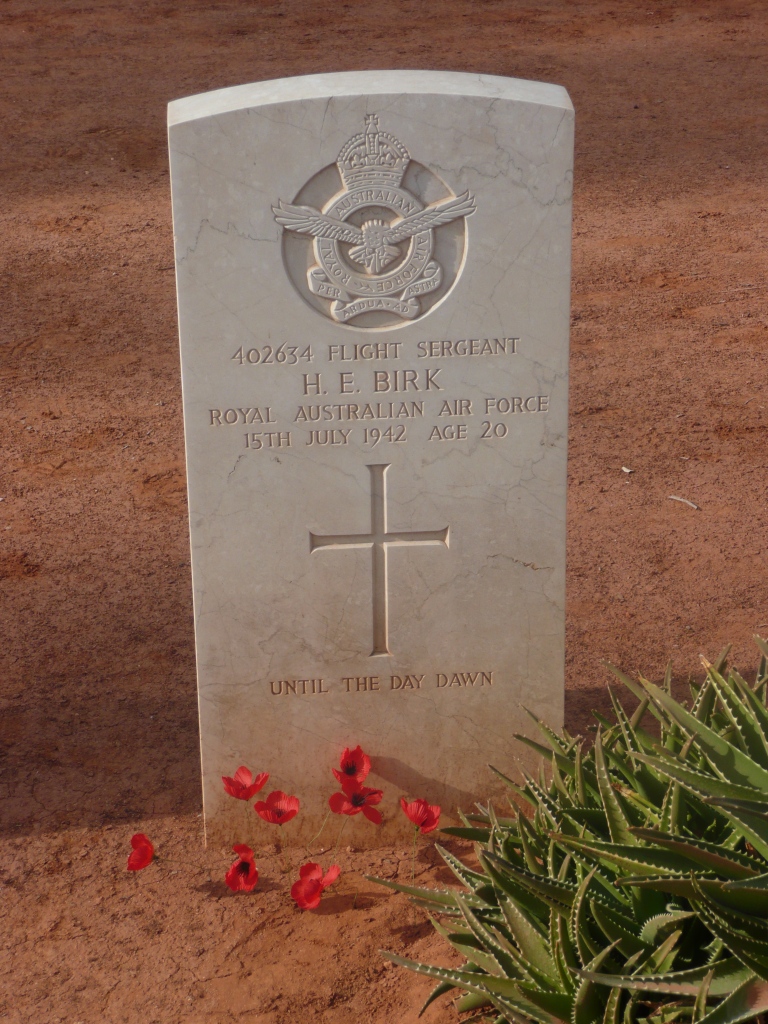 Flight Sergeant
Hilary (Larry) Eldred BIRK,
402634, 99 Squadron Royal Australian Air Force reached Spain with Jack
Newton 10/12/1941 he arrived in Gourock Scotland from Gibraltar on the
10th March 1942. He returned to active service but was killed in North
Africa on
Wednesday, 15th July 1942. Age 20. Albert Day describes Larry as a
constant joker, on his return from Spain when walking around London
with Albert, Larry would lead an imaginary dog, stopping to allow it to
urinate and refusing to go in restaurants that would not allow dogs in.
He was the son of the Revd. George Phillip Birk and Elvy Grace Birk, of
Croydon, New South Wales, Australia. Buried at
BENGHAZI WAR CEMETERY, Libya 6. E. 20.
Flight Sergeant
Hilary (Larry) Eldred BIRK,
402634, 99 Squadron Royal Australian Air Force reached Spain with Jack
Newton 10/12/1941 he arrived in Gourock Scotland from Gibraltar on the
10th March 1942. He returned to active service but was killed in North
Africa on
Wednesday, 15th July 1942. Age 20. Albert Day describes Larry as a
constant joker, on his return from Spain when walking around London
with Albert, Larry would lead an imaginary dog, stopping to allow it to
urinate and refusing to go in restaurants that would not allow dogs in.
He was the son of the Revd. George Phillip Birk and Elvy Grace Birk, of
Croydon, New South Wales, Australia. Buried at
BENGHAZI WAR CEMETERY, Libya 6. E. 20.
Hilary BIRK's brother
Doric Philip BIRK was also killed in the war. He was a Flight Sergeant in the Royal Australian Air Force 460 Squadron flying in a Lancaster III LM324 AR-
Which crashed on a mission to Oberhausen. He is buried at Heverlee War Cemetery Belgium.

|
Pilot Officer John
Learned IVES J/92827 271
Sqdn., Royal Canadian Air Force reached Spain 10/12/1941 he returned to
active service but was killed in a plane crash in the English Channel
on Saturday, 28th April 1945. Age 24. He was the son of Carroll Sanborn
Ives and Gladys Emma Ives, of Sherbrooke, Province of Quebec, Canada.
He is commemorated on the RUNNYMEDE MEMORIAL, Surrey, United Kingdom,
Panel 280. |
 |
Flight Lieutenant Howard
Bertram CARROLL 68806 207
Squadron RAF.(On the left of the photograph with his cousin Spitfire
pilot J. Dudley McCarthy) He was the son of Bertram Howard Carroll and
of Ida May Carroll (nee Hunter)from Romford Road, Manor Park, London
E12. . He probably stayed at least one night at Jean Vandenhove's
tobacconist shop. After reaching Spain with Jack Newton, Hilary Birk
and Gerard WAUQUEZ he arrived back in Plymouth by flying boat on the
21st January 1942 and returned to active service.
He was killed in a flying accident on Monday, 19th November 1945 age 24
and is buried in HANOVER WAR CEMETERY, Germany
Grave Reference 14. B. 15. |
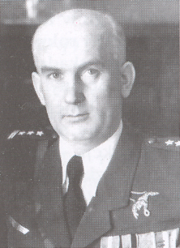 Szczepan SCIBIOR ,
born Uniejow Poland 13th December 1903, was the pilot of the Wellington bomber that crashed near Charleroi
in 1941 with Comete Line evaders Michel KOWALSKI and Stephan TOMICKI as crew.
He was captured in Brussels at 268 Rue Alsembourg the house of Marie Le Gal, after being in hiding for nine days.
Following liberation by the British from prisoner of war camp at the end of the war, Scibior moved to UK,
but in March 1946 he returned to his native Poland. On his return he took
command of 7th Air Bomb Regiment in Leczyca and in August 1947 he was in charge
of Polish Air Force Academy in Deblin. He was arrested on August 9, 1951 and
wrongly accused of being a British spy. He was tortured, tried and sentenced to death on May 13th 1952.
Szczepan Scibor was executed on August 7, 1952.
Szczepan SCIBIOR ,
born Uniejow Poland 13th December 1903, was the pilot of the Wellington bomber that crashed near Charleroi
in 1941 with Comete Line evaders Michel KOWALSKI and Stephan TOMICKI as crew.
He was captured in Brussels at 268 Rue Alsembourg the house of Marie Le Gal, after being in hiding for nine days.
Following liberation by the British from prisoner of war camp at the end of the war, Scibior moved to UK,
but in March 1946 he returned to his native Poland. On his return he took
command of 7th Air Bomb Regiment in Leczyca and in August 1947 he was in charge
of Polish Air Force Academy in Deblin. He was arrested on August 9, 1951 and
wrongly accused of being a British spy. He was tortured, tried and sentenced to death on May 13th 1952.
Szczepan Scibor was executed on August 7, 1952.
In 1956 he was fully rehabilitated.
His symbolic tomb is located at Warsaw's Powazki Military Cemetery.

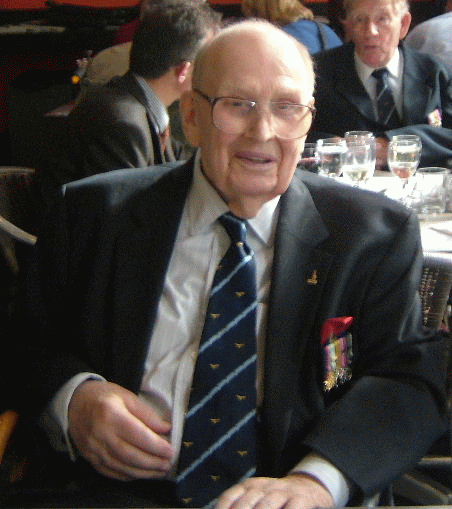 Sergeant Albert
DAY RCAF 10263 77 Squadron
RAF reached Spain 25/12/1941. Albert could not leave Brussels earlier in
December 1941 when Burke and Carroll went south as he had double pneumonia. Madame Jeanne Monnier in Colonel
Remy's book 'Reseau Comete' relates the story. "Baron
Donny ran everywhere searching for a doctor, but I saw him return empty
handed. He told me it was impossible to find anyone. I then told him I
would find someone. I would get my own doctor who lived on the other
side of the street. . . so I telephoned Dr Raymond Kraekels. . . . he
took care of Albert, visiting him twice each day. . . . he saved him. ."
Sergeant Albert
DAY RCAF 10263 77 Squadron
RAF reached Spain 25/12/1941. Albert could not leave Brussels earlier in
December 1941 when Burke and Carroll went south as he had double pneumonia. Madame Jeanne Monnier in Colonel
Remy's book 'Reseau Comete' relates the story. "Baron
Donny ran everywhere searching for a doctor, but I saw him return empty
handed. He told me it was impossible to find anyone. I then told him I
would find someone. I would get my own doctor who lived on the other
side of the street. . . so I telephoned Dr Raymond Kraekels. . . . he
took care of Albert, visiting him twice each day. . . . he saved him. ."
Albert Day remembered the actual story
differently. At Madame Duporque-Monnier house he met a pharmacist
called Leo who worked at the main hospital in Brussels. When Albert was
ill with bronchial-pneumonia, and Baron Donny was unable to find a
doctor, Leo contacted a Doctor Lardot at the hospital who was able to
obtain the drugs to treat Albert.
Albert Day died at his home in St.Louis, Missouri on the 15th March 2007.
A great supporter of the Royal Air Forces Escaping Society and more recently the Escape Lines Memorial Society,
Al will be much missed by his many friends.
Rest in Peace Al.
Both Jack
NEWTON
and
Richard COPLEY have given me
information for this web site.
Jack Newton arrived in Pembroke, Wales in a Sunderland flying boat on the 14th
January 1942. The first RAF man to return to Britain with the
assistance of the COMETE Line. After the war Jack became a Foreign
Service officer and lived in East Sussex. On the 22nd October 2000 he
attended the annual reunion with their rescuers in Brussels.
arrived in Pembroke, Wales in a Sunderland flying boat on the 14th
January 1942. The first RAF man to return to Britain with the
assistance of the COMETE Line. After the war Jack became a Foreign
Service officer and lived in East Sussex. On the 22nd October 2000 he
attended the annual reunion with their rescuers in Brussels.
Click on The Times 23/10/2000 (in the contents column) to read a report
on the reunion.
He died on the 27th January 2004 shortly after his biography "Evader"
by Derek Shuff was published.
" ... How then can I live among this gentle, obsolescent breed of
heroes, and not weep? Unicorns, almost, For they are fading into two
legends ...."
Keith
Douglas (1920-1944)
Richard Copley had a eventful if short wartime career in the RAF.
On the 13th June 1940 he was with 12 Squadron part of the Advanced Striking Force flying in
Fairey Battles from Souge 25 miles South East of Le Mans.
His aircraft a Battle I L5324 PH piloted by Pilot Officer J. S Shorthouse the Navigator/Bomb Aimer was
Sgt Norman Clifford COTTERELL and Richard was the Wireless Operator/Gunner.
They took off at 17.50 to bomb Panzers reported to be
refuelling in the Foret de Gault area. The aircraft was attacked
by four Me 109's and caught fire and crashed killing Norman Cotterell.
The pilot and Richard parachuted out from the burning plane
and were injured, Shorthouse having burns and Richard an injured right foot.
Altogether Richard flew 12 operations in Fairey Battles four of them in daylight.
By June 1940 Richard was flying in Wellingtons with the crew Squadron Leader Grenville Kitching,
Brian Rutterford, Henry Helmore, John Pickering and Cecil Landon, he flew five
times with this crew but was ill with tonsilitis when on the 27th June they took off on a mission to Bremen.
The plane was lost and all were killed including Richard's temporary replacment Flight Sergeant Alfred Bunker.
On July 24th he was the Wireless Operator aboard Wellington W5397 E commanded by Wing Commander Roger Maw and crewed by amongst others Burrell and Porteus
who stories were told elswhere in the website. They took of in daylight for a raid on the German battleships Scharnhorst, Gneisenau and Prinz Eugen mored
at Brest in France. Wing Commander Maw described the mission as " This was a dicey do" and he was awarded the DFC for this operation.
The raid on Aachen was Richard's eighth operation in Wellingtons.
After his capture in Brussels Richard was taken to Dulag Luft
 |
Copley
in Stalag VIIIB
Lamsdorf 1941 |
Obereursel near Cologne 11 Oct to 15 Oct 1941 , Stalag VIIIB Lamsdorf
19 Oct 41 to 3 May 1942. StalagLuft III Sagan 4 May 1942 to 19 May
1943. Hw was POW no. 24364 at Stalag Luft 6 Hyderkrug near Klaipeda in
Lithuania, 40 kilometers Northwest of Tilsit from 22 May 1943 to 16 Jul
1944. Finally he was at Stag 357 Thorn from 15 Jul 1944 to 13 Aug 44
and Fallingbostel 15 Aug 44 to 6 Apr 45. He was liberated at WENDISCH
EVERN on 18th April 1945 by units of the 11th Armoured Division, 2nd
British Army. He was released from the RAF in December 1945 with the
rank of Warrant Officer he made to two return trips to Belgium to see
those who helped him before emigrating to Canada in 1955. He writes on
18th August 2000:
"I have gone
through the expanded web site again very carefully and am deeply
impressed with the courage and fortitude of the Belgian people and all
who gave of their best, including their lives. It is important that
they not be forgotten which is why web sites such as yours are
invaluable and of great interest for future generations.
Regards
Richard"
|
Click on www.belgiumww2.info
to go to INTRODUCTION
next page

©
John
Clinch
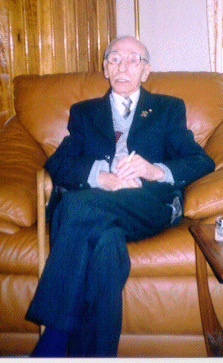
 One of Duncan Geig's Belgian companions in the Pyrenees, student Nester A. G. BODSON (pictured left) was born in 1921,
son of a
schoolmaster, he was parachuted back into into Belgium on the 27th August 1942
as "Springbok" a wireless operator for the agent "Bull". He was
captured straightaway, the parachute drop had been set up by the
Germans using the captured wireless of Fonck code-name "Balaclava".
Nester Bodson refused to talk, he gave his name, his sergeant's rank
and army number and that was all. Fourteen months later , on the 5th
December 1943, he was shot.
One of Duncan Geig's Belgian companions in the Pyrenees, student Nester A. G. BODSON (pictured left) was born in 1921,
son of a
schoolmaster, he was parachuted back into into Belgium on the 27th August 1942
as "Springbok" a wireless operator for the agent "Bull". He was
captured straightaway, the parachute drop had been set up by the
Germans using the captured wireless of Fonck code-name "Balaclava".
Nester Bodson refused to talk, he gave his name, his sergeant's rank
and army number and that was all. Fourteen months later , on the 5th
December 1943, he was shot. 




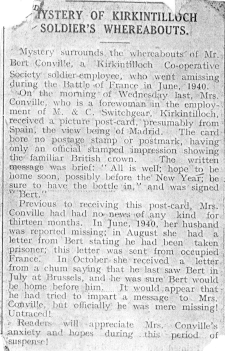
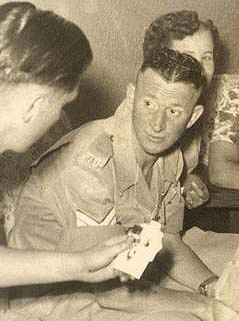


 Flight Sergeant
Hilary (Larry) Eldred BIRK,
402634, 99 Squadron Royal Australian Air Force reached Spain with Jack
Newton 10/12/1941 he arrived in Gourock Scotland from Gibraltar on the
10th March 1942. He returned to active service but was killed in North
Africa on
Wednesday, 15th July 1942. Age 20. Albert Day describes Larry as a
constant joker, on his return from Spain when walking around London
with Albert, Larry would lead an imaginary dog, stopping to allow it to
urinate and refusing to go in restaurants that would not allow dogs in.
He was the son of the Revd. George Phillip Birk and Elvy Grace Birk, of
Croydon, New South Wales, Australia. Buried at
BENGHAZI WAR CEMETERY, Libya 6. E. 20.
Flight Sergeant
Hilary (Larry) Eldred BIRK,
402634, 99 Squadron Royal Australian Air Force reached Spain with Jack
Newton 10/12/1941 he arrived in Gourock Scotland from Gibraltar on the
10th March 1942. He returned to active service but was killed in North
Africa on
Wednesday, 15th July 1942. Age 20. Albert Day describes Larry as a
constant joker, on his return from Spain when walking around London
with Albert, Larry would lead an imaginary dog, stopping to allow it to
urinate and refusing to go in restaurants that would not allow dogs in.
He was the son of the Revd. George Phillip Birk and Elvy Grace Birk, of
Croydon, New South Wales, Australia. Buried at
BENGHAZI WAR CEMETERY, Libya 6. E. 20. 

 Szczepan SCIBIOR ,
born Uniejow Poland 13th December 1903, was the pilot of the Wellington bomber that crashed near Charleroi
in 1941 with Comete Line evaders Michel KOWALSKI and Stephan TOMICKI as crew.
He was captured in Brussels at 268 Rue Alsembourg the house of Marie Le Gal, after being in hiding for nine days.
Following liberation by the British from prisoner of war camp at the end of the war, Scibior moved to UK,
but in March 1946 he returned to his native Poland. On his return he took
command of 7th Air Bomb Regiment in Leczyca and in August 1947 he was in charge
of Polish Air Force Academy in Deblin. He was arrested on August 9, 1951 and
wrongly accused of being a British spy. He was tortured, tried and sentenced to death on May 13th 1952.
Szczepan Scibor was executed on August 7, 1952.
Szczepan SCIBIOR ,
born Uniejow Poland 13th December 1903, was the pilot of the Wellington bomber that crashed near Charleroi
in 1941 with Comete Line evaders Michel KOWALSKI and Stephan TOMICKI as crew.
He was captured in Brussels at 268 Rue Alsembourg the house of Marie Le Gal, after being in hiding for nine days.
Following liberation by the British from prisoner of war camp at the end of the war, Scibior moved to UK,
but in March 1946 he returned to his native Poland. On his return he took
command of 7th Air Bomb Regiment in Leczyca and in August 1947 he was in charge
of Polish Air Force Academy in Deblin. He was arrested on August 9, 1951 and
wrongly accused of being a British spy. He was tortured, tried and sentenced to death on May 13th 1952.
Szczepan Scibor was executed on August 7, 1952.
 Sergeant Albert
DAY RCAF 10263 77 Squadron
RAF reached Spain 25/12/1941. Albert could not leave Brussels earlier in
December 1941 when Burke and Carroll went south as he had double pneumonia. Madame Jeanne Monnier in Colonel
Remy's book 'Reseau Comete' relates the story. "Baron
Donny ran everywhere searching for a doctor, but I saw him return empty
handed. He told me it was impossible to find anyone. I then told him I
would find someone. I would get my own doctor who lived on the other
side of the street. . . so I telephoned Dr Raymond Kraekels. . . . he
took care of Albert, visiting him twice each day. . . . he saved him. ."
Sergeant Albert
DAY RCAF 10263 77 Squadron
RAF reached Spain 25/12/1941. Albert could not leave Brussels earlier in
December 1941 when Burke and Carroll went south as he had double pneumonia. Madame Jeanne Monnier in Colonel
Remy's book 'Reseau Comete' relates the story. "Baron
Donny ran everywhere searching for a doctor, but I saw him return empty
handed. He told me it was impossible to find anyone. I then told him I
would find someone. I would get my own doctor who lived on the other
side of the street. . . so I telephoned Dr Raymond Kraekels. . . . he
took care of Albert, visiting him twice each day. . . . he saved him. ." arrived in Pembroke, Wales in a Sunderland flying boat on the 14th
January 1942. The first RAF man to return to Britain with the
assistance of the COMETE Line. After the war Jack became a Foreign
Service officer and lived in East Sussex. On the 22nd October 2000 he
attended the annual reunion with their rescuers in Brussels.
arrived in Pembroke, Wales in a Sunderland flying boat on the 14th
January 1942. The first RAF man to return to Britain with the
assistance of the COMETE Line. After the war Jack became a Foreign
Service officer and lived in East Sussex. On the 22nd October 2000 he
attended the annual reunion with their rescuers in Brussels.